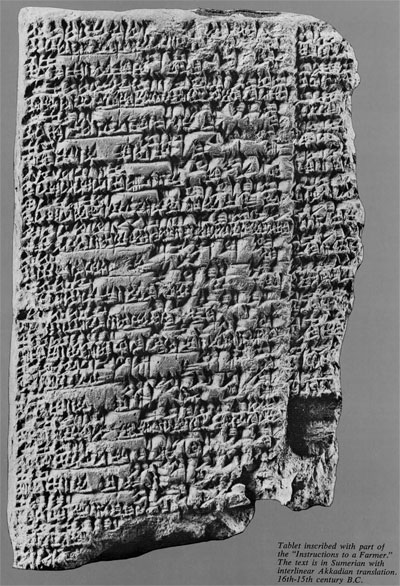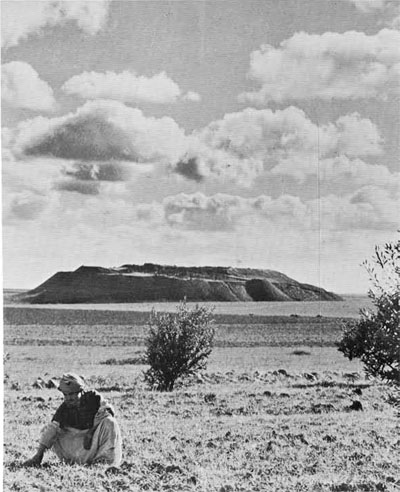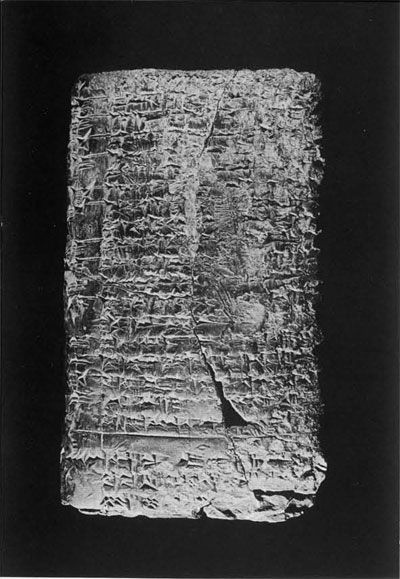Busy with important researches such as establishing a tight chronological frame for Mesopotamian history, clarifying the role of the various gods in the mythology, or attempting to describe the psychological motivations of Sumerians and Akkadians, and with thousands of tablets still to be translated and edited, cuneiformists seem to have little time to dwell upon the minute details of everyday life in the Mesopotamia of four thousand years ago, and its material conditions.

Museum Object Number(s): B1354
Sources to reconstruct everyday life in ancient Mesopotamia, however, are not scarce: thousands of economic texts–15,000 of them for a period of only about eighty years during the third Ur dynasty have already been published!–with concrete and meticulous information about the humblest transaction. An increasing number of Sumerian literary compositions, written in colloquial language, full of jokes and allusions to everyday life, are being pieced together, while hundreds of popular proverbs have been preserved. All this material should suffice to draw a profile of the Mesopotamian as a plain human being, free of the mist of legend and without the distortion of religious speculations.
Let us, for instance, take the culminating moment of the year: harvest time. In the agriculture-based economy of that time, everything depended on the crops. A plentiful harvest meant not only sufficient food, but also the possibility of exchanging the surplus for other commodities. For example, a three-year-old donkey could be had for 32 1/2 bushels of barley. and a hundred bricks were worth about one bushel. A rich harvest afforded the means of increasing livestock and feeding it during the winter months, and repaying the loans which had helped the farmer weather the hard times, and which were given to him on the condition of “being returned on, or after, the harvest,” the usual rates being twenty per cent for loans of barley, although loans without interest are also reported.
The harvest was preceded by six months of work. The sowing period for barley extended from mid-October to mid-December, and the grain would start sprouting, if sown early enough, about the third week of December. The corresponding dates for wheat were one or two weeks later. Although the price of wheat was twice that of barley, the farmers preferred to plant barley, for the same reason that it is preferred nowadays in southern Iraq: barley is better adapted than wheat to a soil of low fertility and high salinity, such as is found in lower Mesopotamia.

A Sumerian didactic composition “Instructions to a Farmer,” a sort of forerunner to Hesiod‘s Erga kai Hemerai and Vergil’s Georgica, has been preserved. It gives advice on how to conduct a model farming operation in cereal culture. Every step, from preparing the field for the yearly flood before sowing, until the end of the winnowing, is carefully explained. From other texts we know that sowing was inaugurated by a feast in which the king himself took the handle of the seeder-plow, after offering sacrifices for the success of the new agricultural season. Sowing was done with a plow, driven by oxen, and fitted with a funnel to drop the seed into the furrows. The scene is clearly represented in an oft-reproduced cylinder seal of the University Museum. The seed was covered by a second plowing across the furrows or by working with a tilted share. After the barley had begun to sprout, the fields were irrigated at least three or four times. The fields needed constant care: weeding the troublesome thorny plants, keeping away the herds of gazelles, “chasing the nomadic shepherds with a club,” etc.
Some time between the second week of April and the first week of May the moment of reaping the rewards for so many efforts finally came. Once the grain had reached maturity, there was not a moment to lose, lest the story destroy the crop or the stalks bend under the weight of the ears. The meticulous bookkeeping of the ancient Sumerians, and their highly organized labor system, give us exact details of the harvesting operations. The harvesters had a hard working day. Each man was supposed to cut seven-eighths of an acre a day, a very respectable area, and that was possible only if he started working with the sickle before dawn, and continued on all day long until dusk.
The mown grain was tied in sheaves and collected in heaps about six yards square. About thirty such heaps were built on each acre, and each worker was expected to make ten of them. “The piles of grain spread over the meadows, are pleasant like the sheep of the divine shepherd Dumuzi, The hills of grain heaped up in the plain, Are like a green mountain full of delight.” After the regular harvesting work was completed the field was left to the gleaners: “orphans, widows, people from destroyed places (i.e., war refugees or victims of a natural disaster such as flood or drought) take baskets and go to glean the leftover ears.” The permission to glean was thus, as later on in the Bible, a sort of “public assistance” for the destitute and poor. Ladies of easy virtue mingled, however, with the other gleaners, to judge from the words of a schoolboy insulting a companion: “you are a hireling, who (instead of working) follows the whores, helping them to carry their baskets of gleaned ears,” and doubtless expecting to be repaid kindly.

Museum Object Number(s): B3657
Meantime the threshing floor had been readied. It was probably just a portion of the fallow land adjacent to the field, of circular shape, and with the soil especially compacted for the occasion. At the same time, wagons, pulled by oxen, were brought to carry the harvested crops to the threshing floor. The model farm described in “Instructions to a Farmer” used wagons, but the available information shows that most of the other farming compounds used the less “mechanized” method of carriers, described somewhat disparagingly as “people chased by the enemies, foreigners, workers with a weak wife and children who tie the sheaves with a rope one cubit long and carry to the threshing floor the grain.”
The “Instructions to a Farmer” often insist that harvesting chores must be carried out by able and strong men (“place strong men in charge of the wagon, place an intelligent man as assistant winnower”), but there seems to have been work for everybody: one worker for instance was hired as “scarecrow” to chase birds away from the piles of grain, and to set bird traps. Human nature being what it is, there was always somebody trying to shirk work. The literary texts sometimes depict a far from flattering picture of some workers, idling around and carrying their own water skin, to make sure that their discomforts would be kept at a minimum: “At harvest time, your work does not match your appetite! You disappear from work, and they find you gossiping in the market place.”
Before threshing, the harvest was left for some time in the fields to dry, where some workers, in addition to the human “scarecrow,” were looking after the shocks, keeping out the water, which in the low-lying fields tended to create puddles. Two methods were used on the threshing floor: beating the grain with a flail, in which case each worker was assigned 6 1/2 bushels to thresh a day, or passing a threshing sledge with “teeth” fastened with leather straps and bitumen, and pulled by oxen, over thin layers of ears. Although the “Instructions to a Farmer” recommend only the use of oxen, other texts inform us of the presence of noisy donkeys during the harvest operations, and the trouble created by these animals, trampling the heaps of grain, loosening the straps of the harness, etc.

Image Number: 6899
Winnowing was a slow operation, and one had to wait for the wind to blow. The amount of grain which each worker was expected to clean every day was therefore very small, 10 1/2 quarts. The piles of clean grain were measured for the last time, and the grain carried to granaries and storehouses, often by boat, the cheapest and most efficient means of transport of those times.
In spite of the hard work, the dominating mood was joy and excitement; sometimes dances were held at night. Unfortunately, no harvest songs seem to have survived. Tavern keepers moved to the fields during the seasons to sell wine to the workers; ambulant vendors, notorious for their abusive language, who during the rest of the year were stationed at the corners of streets and market places, sold roasted barley, a very popular delicacy. The “Instructions to the Farmer” recommended that religious feasts be celebrated three times during the harvest: after piling up the sheaves, between threshing and winnowing, and at the end. The last one, very probably with thanksgiving overtones, was a nocturnal festival.
With the grain safely in, the time came for spending the newly acquired wealth, building houses, and enlarging stalls and sheepfolds. With the approach of summer, cam the time to hunt stags and boars, to catch birds, and to collect the summer crops: onions, cucumbers, and all sorts of vegetables. It was then the hot season–“the time to sleep on the roof, to sit in the shade, and to drink beer,” and why not, the time of dreaming about the crops to come.
